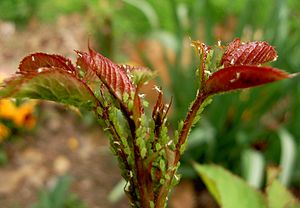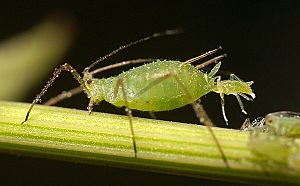Parthenogenesis facts for kids
Parthenogenesis is a special way some animals and plants make babies. It's a type of asexual reproduction, which means it doesn't need a male and a female to create new life. In parthenogenesis, a female lays eggs, and these eggs develop into new individuals without being fertilized by a male. This means all the genes (the instructions for building the new baby) come only from the mother.
This type of reproduction happens in both plants and animals, but it's much less common than sexual reproduction (where a male and female are both needed). You can even find it in animals with backbones, like over 80 different kinds of reptiles, amphibians, and fish where males are no longer part of the baby-making process.
Contents
How Aphids Reproduce
Some animals and plants can switch between making babies sexually and asexually. A great example is the aphid, also known as greenfly.
Aphid Life Cycle
Aphids often reproduce using parthenogenesis during the warm summer months when there's plenty of food. During this time, female aphids usually give birth to live young, called nymphs, without needing a male. These female aphids might or might not have wings.
As the weather gets colder in autumn, males start to appear. Then, the females switch to sexual reproduction and lay eggs. These eggs can survive the winter and hatch in the spring. Because aphids can switch between these two ways of reproducing, it's called 'cyclical parthenogenesis'.
Rotifers: All-Female Animals
There's a whole group of tiny animals called Bdelloid rotifers where scientists have never found any males! This means they reproduce entirely through parthenogenesis. It's the largest group of animals known to reproduce only this way.
Related pages
Images for kids
-
Honey bee on a plum blossom
-
Komodo dragon, Varanus komodoensis, rarely reproduces offspring via parthenogenesis.
-
Example crosses between pool frog (Pelophylax lessonae), marsh frog (P. ridibundus) and their hybrid – edible frog (P. kl. esculentus). First one is the primary hybridisation generating hybrid, second one is most widespread type of hybridogenesis.
See also
 In Spanish: Partenogénesis para niños
In Spanish: Partenogénesis para niños





